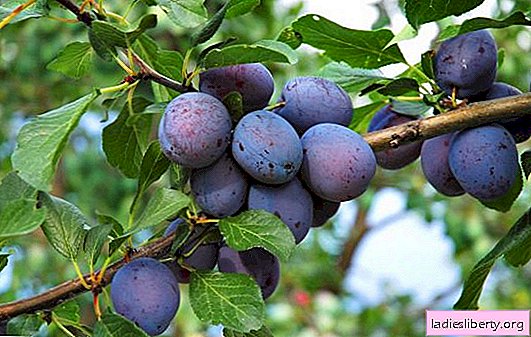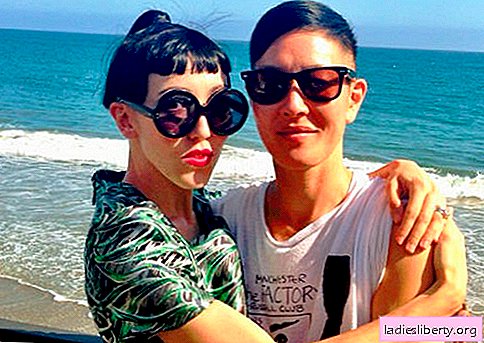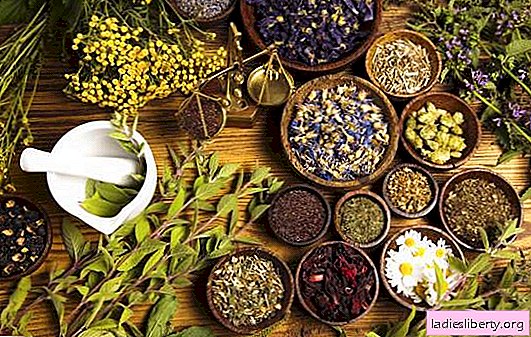
Plum is a very healthy fruit, it is used to prepare various preparations and fresh. However, gardeners are not always able to collect a large crop on their site.
Bad weather and other factors reduce the likelihood of pollination, which affects crop yields. Self-fertile plum varieties come to the rescue, which does not require pollination. These trees have many advantages, they are gaining popularity among summer residents.
Self-made plum varieties with red fruits
The fruits of red plum contribute to weight loss, eliminate iron deficiency in the blood, improve blood coagulation.
The best self-fertile varieties among red plums are considered to be:
• Oryol dream;
• Red ball;
• Gigantic.
Variety "Oryol Dream" was bred on the basis of the old variety "Annushka". The tree turned out with a pyramidal spreading crown. Good leafy. The height of an adult plant does not exceed 2.5 m. The first crop is removed 4 years after planting. By ripening, the fruits are mid-season. Flowering occurs in May, the crop fully ripens only in the month of July.
The fruits of the Oryol plum are distinguished by their large size, dense pulp, and sugar content. The taste is sour. The skin is red and the flesh is light yellow.

Variety "Oryol Dream" tolerates frosts well. Even the kidneys do not suffer from temperature differences. Suitable for growing in the central strip of Russia.
But you can not do without cons. During the period of abundant fruiting, plums may become smaller.
Variety "Red Ball" has been known for a long time. It was bred by crossing varieties "Burbank" and "Ussuri red." The tree turned out to be compact, not exceeding 2.5 m. It comes into bearing early, already a year or two after planting. The yield is high, the fruits are large, the average weight of one plum is 40 g. The peel of the fruit is dense, red with a waxy coating. The pulp is friable, but very juicy, yellow.

Plum "Red Ball" tolerates transportation well, rarely gets sick and can withstand frosts. The disadvantages include the ability of the fruit to grind.
Self-produced plum of the Gigantic variety produces a yield of up to 40 kg per tree. The plant is vigorous, reaches a height of 4 m. It begins to bear fruit 3-4 years after planting. By maturity, the plum belongs to the middle varieties. It tolerates frosts up to -35 ° C, suitable for cultivation in regions with harsh climates.
The fruits are very large, the average weight of one plum reaches 80 g. The skin is dense, pink-red. The pulp is juicy, tasty, with acidity.
Among the minuses, varieties distinguish low drought tolerance of the tree, poor resistance to disease. To collect a good crop, you need to resort to preventive measures. In addition, the bone from the fetus is poorly separated, which many do not like.
Dark varieties of self-fertile plums
One of the popular varieties of blue plum is the "President." The tree is medium-sized, reaches a height of about 3.5 m. It tolerates a drop in temperature to -30 ° C, rarely gets sick. Productivity of the variety at a height, from one young tree you can collect up to 30 kg of fruit. Every year, productivity is growing, adult plum yields up to 70 kg per tree.
“President” plum fruits are large, weigh about 70 grams. The skin is dark purple, dense. The pulp is sweet.
Positive aspects of the "President" variety:
• high productivity;
• large fruits;
• good immunity;
• drought tolerance.
The tree begins to bear fruit 5 years after planting. But it requires crown formation and thinning. If these procedures are not carried out, then the yield falls, the plum suffers from pests and diseases.

No less good is the self-fertile plum variety "Anna Shpet." The fruits of the tree are used for the preparation of dried fruits, freezing and processing. The variety is appreciated for its dark purple fruits, which have a good taste. The pulp is juicy, moderately fibrous, dense

The tree is very tall, tolerates frosts well and is well restored. Plum productivity is good, an adult plant gives up to 60 kg of fruit.
Among the disadvantages of the variety are:
• strong tree growth;
• poor disease resistance;
• loose wood.
The tree needs thinning, preventive spraying. They plant it in a place protected from strong winds, otherwise the branches may suffer.
Yellow self-fertile plums: a description of the varieties with a photo
The variety "Yellow self-fertile" is gaining popularity among gardeners. And this is no coincidence, plum is considered one of the highest yielding. The tree is tall, but slightly leafy, its crown is sprawling. It bears fruiting in the third year after planting. Harvest ripens in the second half of summer.

Fruits of medium size, rounded, yellow, covered with dense skin. The pulp is juicy, tasty, not loose. Plums tolerate transportation well.
Positive features of the variety "Yellow self-fertile":
• high frost resistance;
• good drought tolerance;
• strong immunity;
• productivity.
There are no shortcomings in the tree, except for its strong growth.
Harvest plum grade "Morning" also refers to self-fertile. It gives good harvests in any weather, is a pollinator for many home varieties.
The tree is low, with a compact crown; it comes into bearing for 5 years of cultivation. Productivity is average, a young tree gives up to 15 kg of plums. Harvest ripens in the second half of summer. Frost tolerance is average, but the seedling is well restored in the spring.

The fruits are small, yellow-green, fragrant and juicy. The pulp is medium density, sweet. The bone separates well. Plum tolerates transportation well.
Features of planting self-fertile varieties and plum care
To get a high yield from self-fertile varieties, first of all, you need to choose a variety suitable for your region and plant it correctly.
Where to plant self-fertile plums
For planting seedlings, take a calm place, preferably the southern slope of the site. Such a place can be created artificially. It is better to start landing in the early spring, as soon as the snow melts.
The landing site is prepared in the fall. They dig the soil well, fill the pit with mineral fertilizers and humus. Pits are located at a distance of 2.5-3 m from each other, as the trees need good lighting.
Seedling Care
Young trees demanding soil moisture. It is impossible to prevent its overmoistening or excessive dryness. Trees are watered once a month. If the summer is hot, then 2-3 times.
Watering is combined with top dressing plums. Although self-fertile varieties do not need regular top dressing, fertilizing them will not hurt. Additional food is added according to the scheme:
• early spring nitrogen fertilizers;
• in the summer, potash and phosphorus-potash fertilizing;
• autumn organics.
It is enough to fertilize once every 2-3 years, provided that the landing pit has been filled, as expected.
Winter preparations
Many varieties of self-produced plums tolerate frosts well, but young seedlings in the early years need shelter. The trunk needs to be spudded, and the branches tied together and covered with non-woven material.
Pruning tips for self-fertile plum varieties
Self-fertile varieties do not need regular pruning, but tree care is needed.
In the first year, the conductor is cut by 20 cm. In the spring of the second year, all side shoots are shortened by 1/3 of the length. In the third year, the procedure is repeated, all extra branches are additionally cut. Next, old shoots are cut for 1 kidney, and young ones are shortened. After the fifth year of cultivation, new shoots are cut, the central conductor is shortened by 25 cm, the side branches are cut to 1/3 of the length.
Crohn is formed every year, dry and damaged shoots are cut. It stimulates fruit growth.











